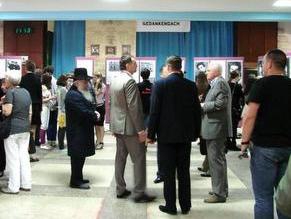|
Euroasian Jewish News

Opening of exhibition in the Museum of Bukovina Jewry
|
Round Table on Creating a Group of Sub-Ethnic Museums Discussed in Kyiv EAJC Office
28.03.2012 On March 27, the Euro-Asian Jewish Congress (EAJC) Kyiv office hosted a round table, he aim of which was to discuss a group of several sub-ethnic museums. The round table especially focused on modern possibilities for keeping records of museum pieces. The event was held at the initiative of EAJC General Council Chairman Josef Zisels. The round table included a teleconference with the head of the project on describing the Judaica collection of Galytsian Jewry, keeper of the Judaica collection of the Lviv Museum of the History of Religion Maksim Martyn.
Participants of the EAJC museum project were able to discuss how museum exhibits are stored and kept record of with experts who work in museums of Kyiv.
Among the experts who participated in the round table were representatives of the Research Department of the Ukrainian Museum of Historic Valuables: leading researcher of the Funds Department Tatyana Romanovskaya and the leading custodian of the museum Elena Podvysotskaya; head of the Kyiv-Mohyla Academy museum Tatyana Lutaya; senior researcher of the “Ivan Gonchar Museum” National Center of Folk Culture Alla Sviridenko; Head Custodian of the Kyiv National Museum of Russian Art Alla Iling; Director of the Sholom-Aleichem Museum Irina Klimova; senior researcher of of the National Ukrainian Museum of Art Yuliya Zacharchuk; and researcher of the Center for the Study of the History And Culture of Eastern European Jewry Natalia Ryndyuk. Leonid Finberg, Director of the Center for the Study of the History And Culture of Eastern European Jewry, EAJC General Council Member Leonid Finberg also participated in the discussion.
All of the participants of the round table supported the idea of creating a group of sub-ethnic museum; however, all present expressed their opinion on the difficulties that implementing this project into practice will involve.
Also discussed were question of choosing a modern computer base for cataloging museum exhibits, and also discussed the standards under which descriptions of exhibits are written.
The EAJC Museum Project
The Euro-Asian Jewish Congress is currently developing a program to create a group of sub-ethnic museums of the history and culture of Jews from various CIS region. An example of such amuseum is the Chernovitsky Museum of the History and Culture of Bukovina Jews, which was created by VAAD Ukraine with the support of the Euro-Asian Jewish Congress.
The group of museums is not to be yet another museum project on Jewry as a whole, but to demonstrate the existence of special local sub-ethnicities: Bukovina Jewry, Galytsian Jewry, Georgian Jewry, Moldavian Jewry, and others. The aim of the project is not to show the life of the Jewish population of the region in all of its forms, but to get across the distinctive feel of Jewish life in the region against the backdrop of complex processes of the development of the local Jewish community in the conditions of certain historic events.
As part of preparation for creating a the sub-ethnic museum group, the EAJC has begun to implement a project on describing Jewish artifacts in Galitsiya (Ukraine), in Moldova, and Georgia. The goal of the project is to create a modern electronic catalogue of Jewish artifacts in the abovementioned regions that complies with the state and European standards of description and has a user-friendly interface.
|
